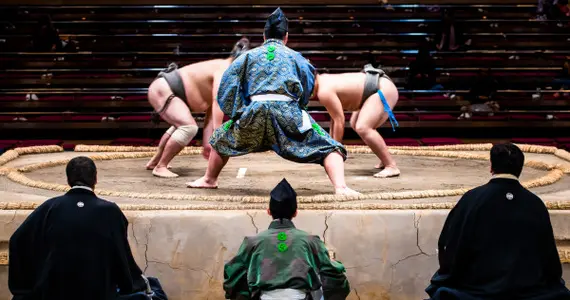Sumo, Japanese Wrestling
- Published on : 20/04/2020
- by : C.W.
- Youtube
The weight of the sky
Sumo is a paradox of brute force and the height of civilization. A handful of seconds combines well-mastered rituals and extreme violence. Two colossal bodies collide and grab, one of them topples or is ousted from the circle and the battle ends, fans cheer. Straight faced, opponents bow to each other and slowly leave the area. Sumo is usually described as a combat sport, a definition that does not fully express its historical, popular and religious importance.
THE HISTORY AND IMPORTANCE OF SUMO
Rikishi (the Japanese generic term for sumo wrestlers) are dedicated to this art from their youth. Usually entering the sumo training stables or "heya" around fifteen years old, they live in this community all day and night. There, with the help of copious chanko nabe (a sort of extremely high protein hotpot), their body turns into that of a sumo wrestler. At five o'clock in the morning, they get up ready to start keiko, the morning training session. Cleaning dormitories, sweeping and meticulously raking the ground. The harsh discipline of the rikishi's practice applies to their whole life.
Watch early morning sumo training with Voyagin.
GIANTS WITH NIMBLE FEET
Stretching is essential; it's done in groups, to a precise and systematic rhythm. Power should not override the fact that sumo is primarily a technical sport. There are eighty-two different holds that the wrestlers practice every day in order to master them.
Within the team, a strict hierarchy is clear: the younger men serve and assist their elders. They prepare the chanko nabe, cook the rice, and take care of all the housework. Six levels exist within the sumo hierarchy. The few who have access to the highest, that of yokozuna, earn a quasi-divine status. Yokozuna retained the title for life and see their names go down in history.
TITANS FROM THE DEPTHS OF TIME
According to ancient history, sumo started about 1,500 years ago. The first trace of its existence appears in 712 in Kojiki (literally "chronicle of old things"), one of the first works written in Japanese. The Japanese soul vibrates watching these titans clash, their hair pulled into a bun reminiscent of the ginkgo leaf, the tutelary tree of Japan.
An integral part of sumo is Shinto. Sumo celebrates the kami, deities present in all things in nature, in order to obtain the kami's goodwill and therefore have a good harvest. It is no coincidence that the great stadium that houses the Tokyo matches, the Kokugikan, has a roof similar to that of a temple. Behind its walls, a circle with a diameter of 4.55 meters is spread on the clay soil, the dohyo, defining victory and defeat. Along with laying the dohyo before fighting, salt is spread - a Shinto practice to purify the arena. Similarly, the grand gesture of wrestlers hitting the ground with their feet is to scare away evil spirits.
The big tournaments, called hon-basho, take place for two weeks in different cities around the archipelago during the odd-numbered months. Tokyo welcomes hon-basho in January, May and September, the city of Osaka in March, Nagoya for the month of July, and finally Fukuoka for the month of November. Television channels broadcast live, and viewing these popular events is often the occasion for large family reunions across the country.
Attend a Sumo training in Japan
HOW TO ATTEND A SUMO TOURNAMENT?
It is completely possible to attend a Sumo tournament during your stay in Japan! But when and where are the tournaments organized? How to reserve places? How much does it cost? The world of Sumo remains mysterious and inaccessible for most travelers but Japan Experience can help you attend a fight, for an unforgettable trip ...
For more information, discover our dedicated article: Attending a Sumo tournament in Japan.
Book your tickets for the Fukuoka sumo tournament!
A NEW FACE FOR THE WORLD OF MODERN SUMO
Since the early 2000s, foreign wrestlers have been winning many of the biggest tournaments. From countries where fighting is important culturally, like Egypt, Mongolia and Bulgaria, wrestlers arrive and soon touch a deep part of Japan's essence. Foreigners are now commonplace at the top of the hierarchy in sumo. Every year, the number of candidates from Japan in the sumo stables decreases, so much so that officials have attempted to introduce quotas limiting the access for foreign nationals. Most measures are in vain, since most of those vying for the yokozuna title are talented immigrants.
Some see it as the swan song of this ancient discipline. For others, this is proof of its popularity. Through sumo, Japan reaffirms the universal appeal of its cultural distinctiveness. It continues by both adapting and respecting its traditions.












